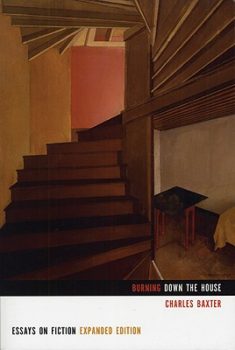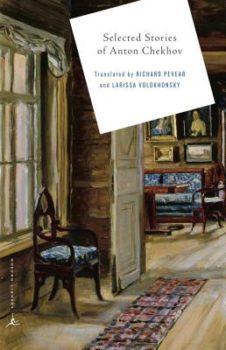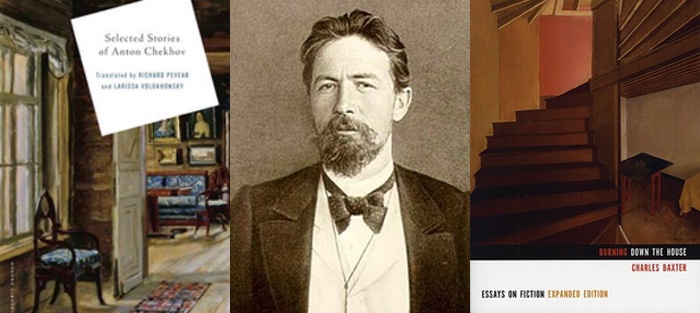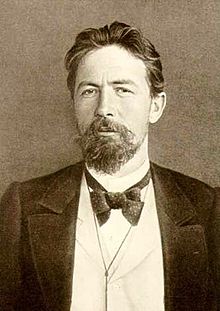Editor’s Note: For the first several months of 2022, we’ll be celebrating some of our favorite work from the last fourteen years in a series of “From the Archives” posts.
In today’s feature, part one of a three-part essay, Christina Ward-Niven explores defamiliarization in Chekhov’s “The Student.” This essay was originally published on December 5, 2016.
A few years ago, as I walked my daughter to her elementary-school classroom, we passed through a hallway lined with student artwork. Her teacher’s name hung above a row of square paintings. “Which one is yours?” I asked.
“I’m not telling you,” my daughter replied. “I hate it.”
I was surprised; she’d always loved art. “Why?”
“My wolf,” she said. “I messed up. It was too late to start over.”
I scanned the wall. “Oh, I’m sure it’s not too bad. Which one?” But my daughter shook her head, and I didn’t push it. I said good-bye at her classroom doorway, and on my way out of the school, I paused again at the wall. Apparently the lesson involved painting a full moon, with circles of light fading into a dark night sky. Each featured a silhouette of an animal, in the foreground on a dark hill. Moonscape with bunny. Moonscape with cat. Moonscape with horse. Bear. Dog. As you’d imagine, the kids’ pictures were sweet, charming. Then I stopped, knowing instantly I’d found my daughter’s painting.
Moonscape with weird amorphous creature.
I could see the attempt at a wolf, and I could detect the desperate effort to fix it, gone wrong. But what struck me, almost with a shiver, was the accidental success she’d achieved. My daughter’s uneven blob had a strangeness to it that made her painting seem mysteriously recognizable. I connected to that blob—I empathized with it, somehow. It looked vaguely human. I sensed a story within the painting: a hunched figure on a hill alone, possibly bundled in a coat or blanket, gazing up at the night sky. The indistinctness of the figure’s shape—was it a person? animal? monster?—made it all the more moving. There was a melancholy in the shadowy image, and some kind of familiar human truth—about isolation, and loneliness, and the wonder of standing on a hill at night, looking up at a beautiful moon.
Yes: I was seriously over-interpreting my third-grader’s artwork, as only a parent can. But I honestly admired the painting, and I still do: It hangs above my desk today and continues to say something to me about the power of strangeness amid the familiar.
This essay is about defamiliarization, which is something my daughter achieved by accident, but which artists, including fiction writers, can use to make the ordinary come to life. By allowing strangeness into our familiar landscapes—the everyday landscapes of our narratives, our characters, and our language—we can surprise the reader into pausing, paying attention, and possibly recognizing some kind of familiar human truth in a new, illuminating way.
But first, let’s consider that word: “strange.” What does it mean? Isn’t strangeness highly subjective? Isn’t it in the eye of the beholder? Yes, which makes this topic admittedly tricky. My dated but reliable dictionary reports that “strange” comes from the Latin extraneus, meaning “external” or “that which is on the outside.” The definition goes on to read, in part, “not native to or naturally belonging in a place: of external origin, kind, or character.” The strangeness I’m thinking of is along these lines. Something not naturally belonging, out of place, seemingly from an external source. In fiction, this translates to something—or perhaps someone, a stranger—unfamiliar or unexpected in the context of a particular story.
Context, then, is important: something will only seem unusual if stands out amid the usual. The context must be familiar on some level for the strangeness to actually seem strange at all. I’ll be looking at fiction based in realism here, though the ideas could apply to most, if not all, varieties of fiction. After all, what we consider odd will change based on the context of a story. In a science-fiction tale set on a distant planet, strangeness might manifest itself in an image we usually consider un-strange fictional fare: a bicycle on the side of a road, a bird, a tree.
 I say “strange,” but I probably mean slightly strange, or moderately strange, as Charles Baxter suggests in “On Defamiliarization” [collected in Burning Down the House: Essays on Fiction, Graywolf Press, 1997]: “The moderately strange in the middle of the ordinary is the lens for focusing the ordinary.” When I first read Baxter’s essay, it addressed something I’d been wrestling with in my own fiction. Like the writers I’ll discuss here, I have a particular interest in conveying everyday life in my stories, in capturing mundane moments and enlarging them, elevating them, maybe even finding new meaning through them. (How can I turn a story about, say, walking the dog, or watching kids play sports, or filling my car with gas, into something meaningful and moving?) Because I read fiction, in part, for the joy of stumbling on moments of surprising truth and insight, I can’t help but want that for my own writing, as well. But I’ve found that thinking directly about truth during the creative process does not always prove helpful; a writer might find herself too wedded to photographic replication of the everyday, too devoted to conveying the world “truthfully,” which often translates to “accurately, clearly.” It doesn’t always translate to “interesting” or “good.”
I say “strange,” but I probably mean slightly strange, or moderately strange, as Charles Baxter suggests in “On Defamiliarization” [collected in Burning Down the House: Essays on Fiction, Graywolf Press, 1997]: “The moderately strange in the middle of the ordinary is the lens for focusing the ordinary.” When I first read Baxter’s essay, it addressed something I’d been wrestling with in my own fiction. Like the writers I’ll discuss here, I have a particular interest in conveying everyday life in my stories, in capturing mundane moments and enlarging them, elevating them, maybe even finding new meaning through them. (How can I turn a story about, say, walking the dog, or watching kids play sports, or filling my car with gas, into something meaningful and moving?) Because I read fiction, in part, for the joy of stumbling on moments of surprising truth and insight, I can’t help but want that for my own writing, as well. But I’ve found that thinking directly about truth during the creative process does not always prove helpful; a writer might find herself too wedded to photographic replication of the everyday, too devoted to conveying the world “truthfully,” which often translates to “accurately, clearly.” It doesn’t always translate to “interesting” or “good.”
As Baxter puts it, “the truth can get dull.” If you are trying to depict a character, event, place, or idea as honestly as possible, it’s quite easy to fall into the trap of too much familiarity. Familiarity is comforting in life, but too much familiarity in fiction can extinguish the potential for surprise—a critical element of a good story. So, how to achieve “truth” in writing, specifically in fiction that embraces ordinary life, without boring the reader or ourselves? Baxter suggests that we “defamiliarize,” or make the familiar unfamiliar through slight strangeness. (Extreme strangeness takes the realistic in a whole other direction, as he points out.) The initial goal of defamiliarization is to destabilize a story. This does not mean destabilization in the sense of damaging or weakening an existing structure, but simply jostling, unsettling, as the wind might shake a rope bridge, causing a walker to hold on tightly, watch more carefully. Defamiliarization has a secondary goal as well, beyond merely getting a reader’s attention: to shine a light on something in a new way.
As writers, we can jostle our reader through a variety of means. We might write in an unexpected narrative event (while filling my car with gas, a complete stranger approaches and climbs into the passenger seat). We could select an unusual point of view (you sit behind the counter at the station’s mini-mart, inhaling fumes each time the door opens, wondering if your grandson will show up this time to take you home after your shift). We can choose unlikely language (“she pulled the snakelike tube through the air, pressed her finger to blackened buttons, and a rush of toxic, flammable, vital liquid shot into the veins of the wheeled box that held her children”). I’m half-kidding with these examples, but I do believe techniques such as these, used alone or in tandem—as contrast to the familiar—can achieve something akin to the surprised sense of recognition I felt when I saw the unidentifiable, yet understandable, figure in my daughter’s painting.
To see how this works in literature, I’ll examine short stories by three writers I admire, all of whom expertly defamiliarize the ordinary: Anton Chekhov, Eudora Welty, and Gina Berriault. I believe all three—to use Charles Baxter’s words—allow us to “recognize ourselves” as we “simultaneously see someone we don’t recognize.”
Odd Narrative Events in Chekhov’s “The Student”
(plus some thoughts on reversals
and the power of unanswerable questions)
Russian short-story master Anton Chekhov is well known for his commitment to conveying everyday life in his stories. In 1886, he wrote to his brother with six features of a good story:
1. absence of lengthy verbiage of a political-social-economic nature;
2. total objectivity;
3. truthful descriptions of persons and objects;
4. extreme brevity;
5. audacity and originality: flee the stereotype;
6. compassion.
His desire to be both truthful and original may be why we can find so many examples of strangeness in the everyday scenes of his fiction.
On the surface, Chekhov’s 1894 “The Student” is the very short, simple story of a young man walking home on a cold evening. He stops to talk briefly to two women, and afterward he experiences a change of mood. It sounds ordinary, and potentially mundane, but Chekhov writes the story in such a way that it feels surprising, moving, and—despite an extreme reversal in the central character—truthful. How does Chekhov unsettle and illuminate in this story of a man’s routine evening?
 When I first reached the unusual ending of “The Student” (which, interestingly, the author said was his favorite of his own stories), I had a series of reactions. First, I was honestly drawn into the student’s joy at the close of the story, when he is overcome with emotion after a conversation with two widows. But my second reaction to the story was something else: uneasiness. The story is undeniably odd—so spare, yet centering on such strong feelings that swing dramatically. Something troubled me about the culminating image, the protagonist marching off happily, as though he’s discovered the entire meaning of life in a few minutes by a campfire. Meanwhile, the two women he encountered remain exactly where they were from the start—but far more upset than they were before he arrived. Was Chekhov satirizing this young man’s extreme change in spirit? Possibly, but “The Student” seems to offer a genuine message about the beauty of connection. If the story is meant to mock the student’s jubilant epiphany, then it is the mildest of mockeries—barely perceptible, in fact. In the end, unsettled thoughts like mine that mark the story’s success. We are forced to pay attention, puzzle through the author’s intent.
When I first reached the unusual ending of “The Student” (which, interestingly, the author said was his favorite of his own stories), I had a series of reactions. First, I was honestly drawn into the student’s joy at the close of the story, when he is overcome with emotion after a conversation with two widows. But my second reaction to the story was something else: uneasiness. The story is undeniably odd—so spare, yet centering on such strong feelings that swing dramatically. Something troubled me about the culminating image, the protagonist marching off happily, as though he’s discovered the entire meaning of life in a few minutes by a campfire. Meanwhile, the two women he encountered remain exactly where they were from the start—but far more upset than they were before he arrived. Was Chekhov satirizing this young man’s extreme change in spirit? Possibly, but “The Student” seems to offer a genuine message about the beauty of connection. If the story is meant to mock the student’s jubilant epiphany, then it is the mildest of mockeries—barely perceptible, in fact. In the end, unsettled thoughts like mine that mark the story’s success. We are forced to pay attention, puzzle through the author’s intent.
First, there’s Chekhov’s characterization—specifically, the very limited characterization of the protagonist. What do we learn about this student? Not much. His name is Ivan Velikopolsky, he’s a seminary student, and he’s the son of a verger (historically a person who handles upkeep in a house of worship). We get no other background information that would prepare us for his transformative moment at the end. This in itself contributes to the story’s oddness, because it establishes a central character who is somewhat recognizable, yet also unknowable. More information might make him less foreign to us, and then we might be less surprised by his actions later in the narrative. The result: a clearer story, maybe? But likely a less interesting one.
Beyond backstory, the real destabilization comes from the events of “The Student”—Chekhov’s choices about what exactly happens to this young man on this cold night. As anyone who has tried to write very short fiction is aware, it’s tough to pull off truly surprising plot events in a brief narrative, especially in a brief narrative that covers such an extremely brief time period; perhaps an hour elapses in the story, at most. How can you tell the story of an ordinary hour and still surprise and affect the reader?
Chekhov begins by setting up a simple, familiar scene, one we can easily envision even in our modern era. (Trudging through the forest becomes commuting in traffic, the samovar becomes a coffee maker.) A student is walking home late on Good Friday, very hungry because he has been fasting for the holiday, and the weather turns harsh. This irritates him and then depresses him. As he spirals downward into a wretched mood, he thinks of how many people before him have been miserable, and how many countless more people will be just as miserable in the future. To make matters worse, he recalls his parents’ bleak state before he left the house earlier in the day, and he realizes: “he did not want to go home.”
This line—“he did not want to go home”—turns out to be key to the events that unfold in the story, because a character actively rejects the familiarity we’d expect him to want when cold and hungry. He makes a choice to steer himself away from the familiar, even if it is only slightly off the path. Why? We get very little explanation, aside from a brief memory of his parents that makes him unhappy (his father coughing, his mother barefoot and polishing the samovar). But people sometimes wander off the path, so we accept as plausible that Ivan would decide to pause and warm up at a nearby fire. At this point Chekhov introduces two new characters, Vasilisa and Lukerya. They are peasant women, both widows—a mother and daughter who tend gardens by the river—who are finishing their supper and cleaning up. Aside from Ivan’s decision to avoid going home, there’s nothing too unusual so far.
This changes when Ivan launches almost immediately into a biblical narrative: the story of the apostle Peter denying Christ three times before the crucifixion. It’s understandable that the student would have Bible stories on the mind; he’s a seminary student, after all, and it’s Good Friday. But why deliver such a long monologue (a full page of uninterrupted speech), outside in the cold, when the weather is awful? And why this particular story? Chekhov’s character recounts not the expected story of Christ’s crucifixion, which is what Good Friday commemorates, but instead the story of Peter’s actions that evening, and Peter’s resulting shame and heartbreak.
“In the same way the apostle Peter warmed himself by a fire on a cold night,” said the student, holding his hands out to the flames. “So it was cold then, too. Ah, what a dreary night that was… At the time of the Last Supper, you remember, Peter said to Jesus: ‘I am ready to go with you, both into prison and to death.’ And the Lord said to him: ‘I tell you, Peter, the cock will not crow this day, before you deny three times that you know me.’ … [Jesus] was bound and led to the high priest, and was beaten, and Peter, exhausted, suffering in sorrow and anguish, you see, not having had enough sleep, sensing that something terrible was about to happen on earth, followed after him … He loved Jesus passionately, to distraction, and now from afar he saw how they beat him …”
The student goes on to describe to the widows the three times Peter is questioned about his connection to Jesus, and Peter’s repeated denial that he knows the arrested man. Ivan concludes:
“And right after that the cock crowed, and Peter, looking at Jesus from afar, remembered the word he had said to him at the supper … The Gospel says, ‘and he went out, and wept bitterly.’ I picture it: a very, very silent and dark garden, and, barely heard in the silence, a muffled sobbing …”
Chekhov’s decision to put this particular Bible story at the center of his own story is an unexpected choice—but the more I think about it, exactly the right choice. The familiar story of the crucifixion might very well have less power to move the two women, or the reader—particularly Russian Orthodox readers of Chekhov’s day—simply because of its overfamiliarity. Jesus’s death is what Christians are supposed to think about on Good Friday. Did Chekhov choose a different Good Friday angle for that reason, simply for a different perspective? Or could it be more than that?
In my Sunday-school youth, the story of Peter’s denial of Christ was perplexing. My child-mind didn’t get it: One (major) error by a devout apostle, okay—but the same one, three times, on the same night? As an adult, I see this story as a heartbreaking tale of mistakes and regret. Peter’s story is an ideal one for literature, because it is truly a human story—one of love, shame, grief, guilt, and loss. So even while it seems unlikely, at first, that a character would discuss it in this context, it becomes a source of connection: we feel for Peter, we understand his sobbing in the garden.
The widows, in their garden, do too. The story visibly moves them: Vasilisa weeps, and Lukerya’s expression is “heavy, strained, as in someone who is trying to suppress intense pain.” The student walks away, and the final paragraphs include the most unusual narrative moment of the story. On first read it seems that Chekhov is bringing us to a joyful ending of sorts, which is surprising in itself; if you’ve read even a sampling of his stories, you know he was not inclined to happily-ever-afters. While leaving the women, the student experiences a complete reversal of spirit. Recall that two pages earlier, walking home, Ivan was in a state of despair:
It seemed to him that this sudden onset of cold violated the order and harmony of everything, that nature herself felt dismayed … hunching up from the cold, the student thought how [in ancient times] … there had been the same savage poverty and hunger; the same leaky thatched roofs, ignorance and anguish, the same surrounding emptiness and darkness, the sense of oppression—all these horrors had been, and were, and would be, and when another thousand years had passed, life would be no better.
Now, realizing the profound effect of his story on the widows, Ivan turns fully from these earlier thoughts of a horror-filled world: “And joy suddenly stirred in his soul.”
In other words, he cheered up. Why does this feel so unsettling and unexpected? People cheer up all the time; sometimes it just takes the right song on the radio, or a surprise uptick in temperatures in February. Ivan’s transformation destabilizes because it is so complete. He is not just a little less miserable after warming up and chatting at the fire. He is ecstatic. The conclusion of the story, as he pauses, looks back toward the women and the fire, and then continues walking, is unmistakably surprising:
The student thought again that if Vasilisa wept and her daughter was troubled, then obviously what he had just told them, something that had taken place nineteen centuries ago, had a relation to the present—to both women, and probably to this desolate village, to himself, to all people. … he kept thinking how the truth and beauty that had guided human life there in the garden [with Peter] … went unbroken to this day and evidently had always been the main thing in human life and generally on earth; and a feeling of youth, health, strength—he was only twenty-two—and an inexpressibly sweet anticipation of happiness, an unknown, mysterious happiness, gradually came over him, and life seemed to him delightful, wondrous, and filled with lofty meaning.
It’s almost too much to accept, all this delight, wonder, and “lofty meaning.” Chekhov pulls it off in part because he’s told us Ivan is a scholar—someone who spends much of his time in his own head. His epiphanic reversal stems from a realization of deep intellectual and emotional significance to him. Still, even if we accept Ivan’s change, we recognize it as an unusual short-story ending. Here, as elsewhere in the story, Chekhov uses narrative events to defy expectation. But to what end? What is the impact of this jostling of readers, beyond simply getting their attention? Defamiliarization isn’t strangeness for the sake of strangeness; it isn’t merely a tool to make an everyday-focused story more interesting—though of course that is a happy byproduct.
This is where illumination and unexpected recognition come in. The story’s surprising reversal leads us to pause, to question. When we do, we realize (even if the central character apparently does not) that this is a more complicated transformation of mood than it might initially seem. The student’s joy comes directly out of the widows’ sorrow. His story about Peter has moved them, and the student is himself moved by the power of “truth and beauty” to connect humans through time. So he, as an academic, walks away full of joy about the prospect of some kind of artistic meaning in a misery-filled world.
The two widows, however, remain behind—they are still troubled, still poor, still out in the cold, left to go on alone without the “youth, health, and strength” he feels so pleased to have. The story quite literally leaves them; when Ivan begins to consider the impact of his words, he looks back and glimpses only firelight: “the people around it could no longer be seen.” The women are no longer visible; they are invisible, as it is likely they will always be, in a sense, as poor unmarried peasant women. The student’s dark thoughts at the start of the story, just a few short pages earlier—paragraphs, really—still linger. They cast a shadow over the ending. The reader knows that Ivan is absolutely correct when he notes, early in the story, that conditions for many people “when another thousand years had passed … would be no better.”
So how can he end up so happy? Perhaps this is where my unsettled feeling is rooted. Why doesn’t the story try to elicit something more—sympathy, sadness—for the two women, in the end? If we look carefully at the text, I think we can find not an answer, but an acknowledgement. The last sentence pointedly reveals that Ivan “was only twenty-two.” The timing of this announcement—the emphasis on Ivan’s youth amid the description of his happiness—seems the author’s way of reminding us: he’s so young. Is it possible the reason he is startled by the women’s emotions is that he is not yet old enough to truly empathize with Peter’s grief and regret? That he did not expect his fireside story to be so moving, because it does not (yet) move him in quite that way? Is it possible he is so purely happy in the end because he is too young to recognize that it was the widows’ connection to Peter’s loss that brought them to tears? It’s very subtle, but the age reminder explains the extremity of the student’s transformation just enough to tell us that the author is well aware of the complex reality.
“The Student” culminates in an illuminating moment for us as readers, though not a fully clarifying moment. But Chekhov was not in the business of providing neatly wrapped solutions. As he famously wrote to publisher Alexei Suvorin in 1888, “You are right to demand that an author take conscious stock of what he is doing, but you are confusing two concepts: answering the questions and formulating them correctly. Only the latter is required of an author.” In “The Student,” we have a series of unusual events that ask questions about empathy, suffering, joy, and finding meaning in a hard world—and though we don’t get the answers, we recognize something about ourselves, and each other, in the asking.







